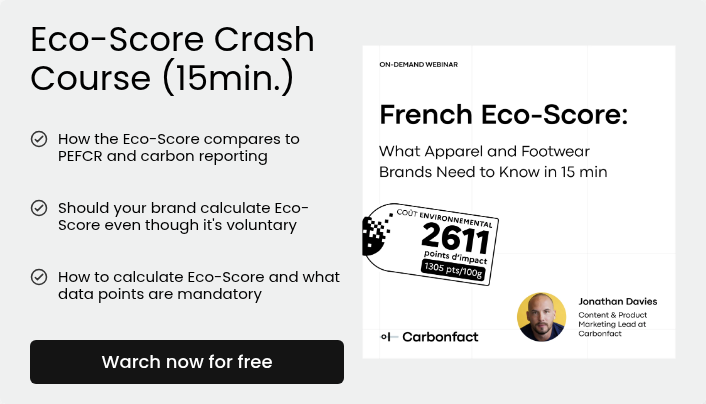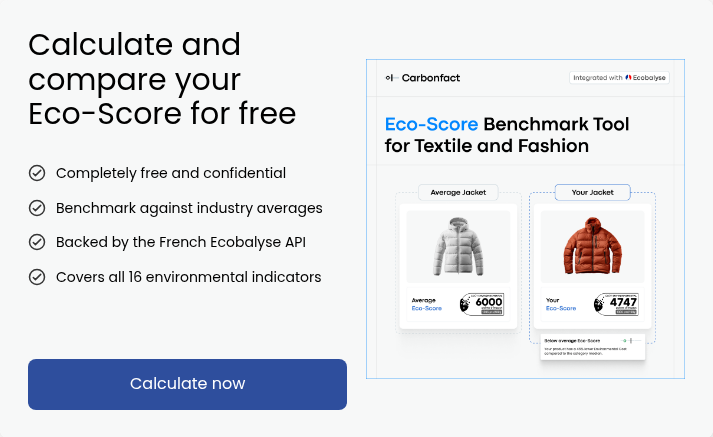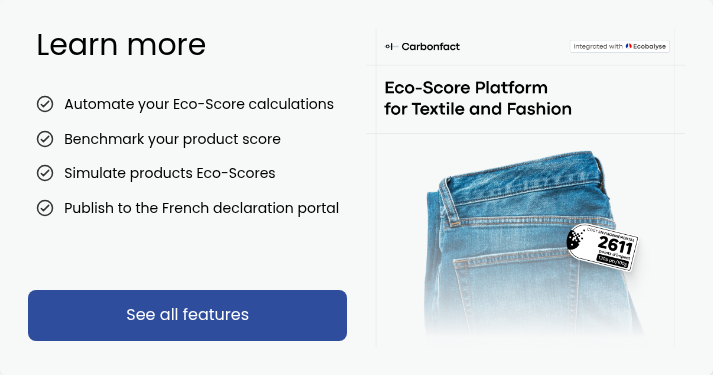Timeline for Textile and Fashion Brands
The final Decree, relating to the methods of calculating and communicating the environmental cost of textile products, was published on September 6th, 2025 - you can find it here. Eco-Score will take effect on October 1, 2025. The latest changes to the texts are mostly editorial and structural, with no major policy changes.
- 1st October 2025: Entry into force. Only brands may voluntarily calculate and submit their product Eco‑Scores to the public portal.
- From October 2026: If the fashion brand has not yet published a score themselves, any third party, e.g. retailers, NGOs, will be able to publish the Environmental Cost on behalf of textile brands – without needing the brand’s prior approval. From October 2026, as well, if the brand communicates any other environmental score (such as carbon footprint on the e-commerce store), then displaying the Environmental Cost label becomes mandatory.
.jpg?width=2000&height=1156&name=2%20(5).jpg)
Who Needs to Comply?
The environmental labeling requirements apply to all producers, importers, and distributors who place textile products on the French market, regardless of its origin. This also means that non-French companies are included if they market products in France. The decree does not explicitly mention exemptions for small fashion brands or specific thresholds of company size.
Which Clothing Categories Are Included?
The Environmental Cost applies only to “produits textiles d’habillement” – clothing items made primarily of textile fibers, whether natural or synthetic, including any trims or integrated component parts.
Products made of more than 20% non-textile materials by mass are excluded. Shoes and accessories are also excluded, even when they contain textile components.
The product categories considered are the following:
1° Boxer / Briefs;
2° Underpants;
3° Socks;
4° Shirt;
5° Jeans;
6° Skirt / Dress;
7° Swimsuit;
8° Coat / Jacket;
9° Pants / Shorts;
10° Pull;
11° T-shirt / Polo.
The following textile products are currently excluded:
- Second-hand products.
- Products of which more than 20% of the mass is composed of materials other than textile fibers
- Products for which more than 20% of the mass is composed of materials whose modelling of the contribution to the calculation of the environmental cost does not appear in the methodological notice (i.e. is not present in the list of Ecobalyse materials)
- Products integrating electronic components.
- Products made from Leather and accessories e.g. belts, scrunchies, cases, pouches, bags, tote bags.
-
Personal protective equipment unless it can be purchased directly by end consumers.
Environmental Cost Methodology and Ecobalyse
Ecobalyse is the official tool developed by the French government to calculate and communicate the environmental impact of textile products. It aims to calculate the “environmental cost” of textiles, reporting on impacts such as water consumption, greenhouse gas emissions, biodiversity damage, and microfiber pollution, using life cycle assessment (LCA).
How It Works
The tool allows users to enter basic product attributes — such as material composition, weight, place of manufacture, and processing — to generate an aggregated environmental impact score, called a “coût environnemental” (Environmental Cost), expressed in numeric points.
Ecobalyse was originally designed with three levels of assessment:
- Level 1: Simplified LCA-based methodology using global-average data.
- Level 2: Integrating brand-provided data from internal systems or questionnaires
- Level 3: A complete, product-specific LCA using primary supply-chain dat
Currently, only Level 1, the simplified LCA-based methodology using global-average data, is required for the environmental cost calculation. Levels 2 and 3 remain under development within Ecobalyse, and it is still uncertain whether they will be implemented in the future.
Currently, Ecobalyse is only available in French. However, Carbonfact has developed a free Carbonfact’s Environmental Cost Calculator and benchmark tool, with an English interface, endorsed by Ecobalyse.
How to Calculate Environmental Cost?
The Environmental Cost must be calculated and displayed for each sales reference, which refers to a unique product colorway (référence couleur). This means that each color of a product requires its own score. The score must be based on a single representative size, as defined by the official size table for each market segment (e.g., men, women, children).
Brands cannot publish different scores for different sizes – the representative size is used as the benchmark for the entire size range of that colorway.
Anyone calculating a product’s Environmental Cost must make the information publicly available. The decree requires that consumers can access it directly at the point of purchase – whether on a product page or on a label at checkout.
Step 1: Life-Cycle Assessment
Ecobalyse models the full life cycle of garments: from raw materials, through processing (spinning, textile formation, coloration and finishing, assembly), to transport and distribution, use, and end-of-life.
Step 2: Compute 16 PEF Impact Indicators
Computes all 16 Product Environmental Footprint categories. Changes to weightings under Eco-Score methodology include: freshwater ecotoxicity is double-weighted, while the two human-toxicity indicators receive zero weight.

Environmental impact categories and weights
Step 3: Normalizations and weightings
To get a single Environmental Cost score, Ecobalyse goes through two steps:
Normalization: Each impact (climate, water, toxicity, etc.) is converted into comparable “impact points.” Ecobalyse uses the same normalization factors as the European PEF method.
Weighting: Each impact is given a share of importance. Here Ecobalyse differs slightly from PEF (climate and ecotoxicity weighs heavier, see the chart).
Step 4: Additional Fashion-Specific Penalties
- Beyond the PEF metrics, Ecobalyse adds two fixed-point categories to capture key apparel issues:
- Export outside of EU: penalizes used garments collected in France that are shipped abroad, instead of being reused or recycled locally.
- Microplastic shedding: assigns points based on the share of microplastic fibers each material releases during washing.
Durability Coefficient
In the Life Cycle Assessment, Ecobalyse adjusts each product’s use phase with a durability coefficient between 0.67 (low durability) and 1.45 (high durability). This coefficient depends on two main inputs:
- Range breadth (50%): How many product references (SKUs) the brand sells in the same category (e.g. women’s T-shirts). A wide range signals rapid trend turnover, typical of fast fashion, and lowers the durability score. If the brand does not provide this data, Ecobalyse applies a default of 100,000 references (worst case).
- Repair incentive (50%)
Based on the ratio between average repair cost and the brand’s reference sales price (retail price of the product), plus whether the brand offers a recognized repair service. If no price or repair info is available, Ecobalyse assumes no repair service and applies conservative defaults.
The resulting coefficient increases or decreases the assumed number of wears for the garment.
Higher coefficient → product lasts longer, impacts spread across more uses → lower cost per wear.
Lower coefficient → product lasts fewer wears, impacts concentrated → higher cost per wear.
Which Data Do You Need to Calculate Environmental Cost?
To generate a compliant Eco-Score, brands (or third parties) must provide product data through the Ecobalyse tool or its API.
Mandatory Parameters
The mandatory parameters in Ecobalyse are the minimum data points needed to generate an Environmental Cost score, ensuring that every product can be scored consistently, regardless of brand data availability.
- Product category
- Mass of the finished product
- Nature & percentage of raw materials
- Geographical Location of textile formation (weaving/knitting)
- Geographical Location of ennoblement (finishing)
- Geographical Location of confection (assembly)
Note: While it is technically mandatory to measure and provide all of these data points, when the manufacturing locations are missing, Ecobalyse will apply “India” as a conservative default value. The Eco-Score is, however, only compliant if the brand delivered primary data for all 6 mandatory data points.
Optional Parameters
Not required, but highly recommended. If left blank, Ecobalyse uses conservative defaults: it assigns “India” as the default country of production, assumes a 100k product range, 100% air transport, and sets all durability-related criteria to reflect ultra–fast fashion.
Providing real values here helps lower the score.
- Remanufactured vs. new status
- Number of products offered in the segment
- Reference price
- Company size & repair-service offering
- Geographical origin of raw material sourcing
- Geographical origin of spinning
- Type & % printed surface (finishing)
- Application of a washing process
- Air-transport share
- List of accessories
NOTE: If you have real data for a given parameter (say, your actual % of air freight or your true repair-service take-up), you must feed those numbers into the calculation and not use defaults.
Fixed Parameters (preset by product type; cannot be changed)
- Spinning type
- Yarn titration
- Weaving/knitting process
- Weight linkage to category
- Dye type (finishing)
- Manufacturing complexity
- Loss rate in confection
- Dormant-stock rate
These parameters are fixed at sector-average values because brand-specific data is hard to verify, their impact on the score is small, and standardizing them keeps results consistent across all products.
Why Should Fashion Brands Calculate the “Voluntary” Eco-Score?
As of one year after entry into force, any person distinct from the manufacturer/importer may calculate and communicate the environmental cost without needing the brand’s consent. “Personne physique ou morale” — NGOs, retailers, comparison websites, industry associations, journalists or even individual consultants can step in and run the official methodology to produce an Eco-Score if the brand itself hasn’t done so, provided that they have access to the mandatory parameters.
Under the AGEC law, brands must already disclose the country of origin for certain process steps and material (fiber) composition is already mandated under existing EU textile labelling regulations. This means that, in practice, third parties could obtain much of the mandatory data needed to calculate the Environmental Cost, making this scenario a realistic possibility.
This could look like:
- Big e-commerce platform integrating Eco-Scores into its product listings, auto-computing scores for any brand that hasn’t published its own.
- Fashion Revolution releasing its annual Fashion Impact Report and calculates missing brand scores using publicly available product data.
- A journalist investigating label transparency independently calculates Eco-Scores for brands that haven’t done so.
However, for missing data, third parties will have to rely on Ecobalyse’s default parameters, which are conservative and result in higher (less favorable) Environmental Cost. This happens because third parties lack access to optional, detailed product data, such as transport modes or production processes, which only brands can provide.

Note: Multiple third-party scores for the same product can coexist on the portal.
Though not a legal requirement, this setup creates a strong incentive for brands to calculate their own scores, because:
- Scores calculated by third parties will result in higher Environmental Cost in high scores.
- Scores calculated by brands themselves will automatically replace third-party scores, with a maximum delay of one month.
.jpg?width=3840&height=2260&name=Group%2059765%20(1).jpg)
When Is Calculating Environmental Cost Mandatory?
If your French website already displays a single environmental score (for example, a carbon footprint on product pages), it will become mandatory to display the official Environmental Cost label from October 2026. In other words, showing the Eco-Score will become mandatory whenever another standalone score is presented.
What Is the Eco-Score Publishing Process?
The online portal for data submission will officially launch on September 15, 2025. Scores uploaded before that date will not be retained. It allows submissions via CSV upload, API, or manual entry, and includes delegation options for third-party representatives (e.g., consultancies or LCA experts). Improvements will be rolled out iteratively.
4 steps:- Calculate the score: Brand may run the official methodology on any medium they choose – their own software, the open-source Ecobalyse code, or the public calculator. The only duty is to follow the calculation rules.
- Immediately after computing the score, the third-party must publish a data record on the government portal designated by the environment and economy ministries.
- Four mandatory fields of information have to be disclosed on the portal: 1) the Environmental Cost in impact points; 2) the list of parameters & any specific data used; 3) the product reference ID and its market-launch date; 4) the calculation date, the legal status of the calculator, and the version of the methodology applied.
- Once the data is on the portal, the brand/third-party may display the score wherever it informs consumers: e-commerce pages, product listings, shelf labels, apps, printed catalogues, social media, etc. The visual must follow the standard label rules.
How Do You Show the Environmental Cost on Your Labels or Online?
Display of the score includes:
- Mandatory Header: Always include the words “Environmental Cost” (in the local language).
- Pictogram of Impact Points: A simple icon alongside the total “points d’impact” calculated for the product.
- Normalization per 100 g: Below (or beside) the total points, display the same number of points recalculated per 100 g of product mass.
- Digital Display: Whenever you show the Environmental Cost on a website or app, you must include a link to the full dataset on the official portal.
Digital Display: Whenever you show the Environmental Cost on a website or app, you must include a link to the full dataset on the official portal.
Graphics: You cannot modify the official design – only scale it up or down proportionally if needed.
Minimum Size Requirements:
- On a shelf label or product page, the Environmental Cost must be at least as large as the price text.
- On physical packaging or hangtags, it must remain clearly legible.
- In all media (print or digital), its size must match or exceed any other environmental score or label you display for the same product.
-1.png?width=1660&height=964&name=3%20(5)-1.png)
Note: Anyone calculating a product’s Environmental Cost must make the label publicly available. The decree requires that consumers can access it directly at the point of purchase, whether on a product page or on a label at checkout.
Textile Eco-Score: Updates and Revisions
The Eco-score framework allows for updates to ensure accuracy and reflect improved data:
- Quarterly Updates: Brands can update their scores every three months with more precise data or corrections.
- Mandatory Revisions: If the methodology or decree is modified, brands must revise their scores within 12 months to remain compliant.
This structured approach ensures that the Eco-Score reflects the most accurate and current information over time.
Methodology: French Eco-Score vs PEFCR
The French Textile Eco-Score is a simplified LCA-based method designed for consumer-facing applications. It introduces novel parameters such as emotional durability and the export of textile waste outside the EU.
The PEFCR for Apparel & Footwear, in contrast, is a more detailed framework. It is supported by the EF 3.1 database and applies the standardized EF 3.1 impact assessment method. Many of the same modeling principles used in the PEFCR also underpin parts of the French framework.
This table summarizes some key differences between the two methods. It is not exhaustive – feel free to suggest additions if you notice other relevant divergences!
.png?width=2000&height=1722&name=Group%2059723%20(1).png)
How Can Carbonfact Help Your Brand?

Automated Eco-Score calculation for all products: Carbonfact imports all your data, generating Eco-Scores for all products in scope without manual work.
Compare against category benchmark products: Carbonfact’s platform allows you to see how your product compares against industry averages and decide whether to publish or improve first.
Simulate and improve your Eco-Score: Use Carbonfact’s Eco-design Tool to simulate products with differing materials and processes – so you can see and improve your score before publishing.
Push data directly to the French declaration portal: Carbonfact is integrated with Ecobalyse, so you can submit your calculated Eco-Scores directly to the French portal.












 Lidia Lüttin
Lidia Lüttin
![[Textile Industry] CSRD - Corporate Sustainability Reporting Directive Reporting Requirements for Apparel and Footwear](https://www.carbonfact.com/hs-fs/hubfs/Regulations-4.png?width=600&name=Regulations-4.png)
